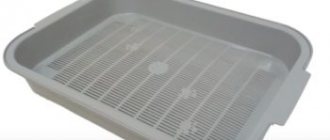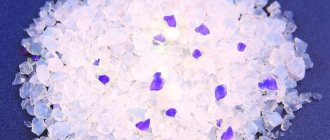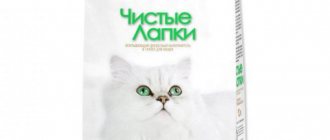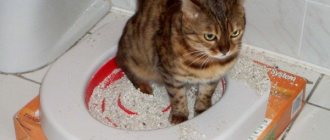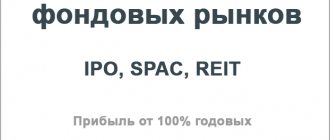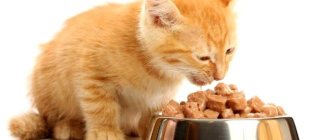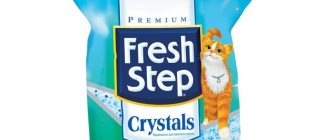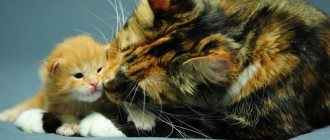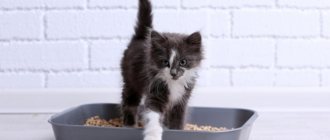When a kitten or an adult cat appears in the house, the owner must create comfortable conditions for the pet’s existence. You need to select food, install a scratching post, pamper your pet with toys, and the most important thing is to decide on a place for the toilet. It is very important for pet owners that their four-legged friend goes to the toilet in a designated place. Often the reason that an animal walks past the litter box is due to inappropriate cat litter. Nowadays, there is a large selection of them and each manufacturer claims that their product is the best. In practice, pets have different preferences. Some are ready to go into the tray without any filling at all. Others only need one that absorbs liquid, neutralizes odor, and doesn't stick to paws.
Let's look at the video about which cat litter is best to buy and the approximate price for cat litter:
Which cat litter would a pet choose?
If cats could choose their own litter, they would pay attention to the following indicators:
- A hygiene product should be comfortable: it should not stick between the paws, and the granules should be pleasant to the touch.
- The composition must have good absorbency so that after urination a “swamp” does not form in the tray.
- For those who like to dig into the tray, the composition should not generate dust. Otherwise, it creates unpleasant sensations and allergies may even appear.
- It is preferable that there is no smell at all or that it is as close to natural as possible.
Absorbent fillers
The group of absorbent fillers is the most numerous in variety. Pros:
- Economical consumption.
- A complete replacement can be done on average in 6-9 days.
- They absorb moisture well and remove odor, but once wet they lose these properties.
- There are many varieties and there are no problems with selection.
Minuses:
- Most types should not be flushed down the toilet.
- Once completely wet, they begin to smell unpleasant.
- May cause health problems if swallowed.
Clay absorbent
Absorbent fillers are also made from clay. To do this, it is dried at high temperature and pressed. Such granules absorb well and do not change their structure.
The layer of clay in the tray must be at least 5 cm, otherwise it will stick to the bottom after the first urination.
The backfill needs to be changed frequently. Clean up stool daily. Granules are produced in different sizes. This is one of the inexpensive varieties.
Wood absorbent
Fillers are made from wood in the form of granules and flakes (see photo). Granules are compressed sawdust from coniferous trees. Their advantage is that they retain moisture well and protect against odor. When urine gets in, the pellets absorb it and crumble. You only need to cover the bottom of the tray with granules, no more, otherwise when soaked they will significantly increase in volume.
Which cat litter is best to use?
The wishes of the owner and his pet for cat litter are largely similar.
Owners will choose litter for cats that best meets the following qualities:
- The main criterion is complete and rapid absorption of urine. This will ensure that there are no dirty marks on the floor after visiting the litter box.
- Absorption of the corresponding unpleasant odor.
- Does not spread on the cat's paws throughout the home.
- Doesn't raise dust when changing or when the cat is doing business in the litter box.
- Simple and convenient replacement.
- Economically used.
- Suitable for flushing waste down the drain.
- Has a reasonable price.
If the cat digs a lot in the tray and the contents spill out, then do not rush to change the litter. Perhaps the problem will be solved if you choose the right litter box for your cat.
What types of fillers are there?
The main quality that any toilet filler should have is the ability to absorb moisture and absorb odors.
Therefore, industrial companies use materials with a high degree of adsorption for production. Of course, they must also be safe for people and pets, as well as simple and easy to use and dispose of.
Fillers are made from natural and synthetic materials, namely:
- wood fillers;
- silica gel;
- mineral;
- bentonite.
Unfortunately, sand and newspaper do not meet the requirements due to the fact that they do not absorb odors, and printing paper and paint can be harmful to health, especially if used on a kitten.
For litter box training, you can use soft toilet paper or absorbent diapers for newborns.
Types of cat litter
There are two classifications of cat litter.
Depending on the method of action, the mixture may clump or absorb.
Clumping cat litter works on the basis that when wet, the granules form a dense ball. This system prevents liquids from spreading and provides convenient cleaning. It is enough to remove the desired lump and add dry granules.
Absorbent cat litter, as the name suggests, works by allowing the granules to absorb liquid. Such material is consumed very quickly. In just a few trips to the toilet, all the pills are clogged with moisture and are unable to absorb any more. To a greater extent, this applies to budget representatives. There are absorbent bases that have greater absorption capacity and they last longer (the manufacturer claims up to 30 days).
According to the composition, cat litter is divided into: mineral mixture, wood, corn, silica gel, clay.
Let's consider which cat litter to choose and their characteristics.
Mineral
Mineral compositions can be either absorbent or clumping. Granules of absorbent mixtures consist of minerals of volcanic origin and have a porous structure. To make clumping mineral compositions, quartz sand and chalk are used.
Advantages:
- They have a natural composition.
- They absorb moisture and odor well.
- As a result, the granules form lumps and prevent the liquid from spreading.
- Using a special spatula with a grid, dirty lumps can be easily removed.
- The remaining dry part remains, which makes its consumption economical.
Flaws:
- Do not flush down the drain.
- Not suitable for animals that are used to chewing everything.
- Quite a lot of dust when cleaning.
- Wet lumps begin to emit an odor over time.
The mineral filler is changed once a week.
Woody
Wood filler is recognized as the safest and most environmentally friendly. Wood shavings (sawdust) are used for its production, which eliminates the possibility of allergies to the product. Sawdust is pressed in a special way, resulting in granules. When wet, they swell and disintegrate back into shavings.
Advantages:
- They are environmentally friendly for pets.
- Granules are produced in different sizes.
- If you flush it down the toilet, nothing bad will happen.
- Different degrees of absorption.
- Has a woody smell.
Flaws:
- If you pour a large amount, sawdust may spill out of the tray when it swells.
- Sawdust is light and in most cases spreads throughout the home.
The wood base will have to be changed at least 2 times a week.
Corn
Corn filler is similar in production and properties to wood filler. This type of hygiene product is not so popular for cats.
More often this type is used for rodents as the most hypoallergenic.
Advantages:
- Absorbs moisture, neutralizes odor.
- Does not harm sewer systems when flushed down the drain.
- It is considered the most hypoallergenic.
- Allowed from a very young age.
Flaws:
- Additional cleaning due to sawdust throughout the property.
Silica gel
Silica gel filler is the most modern. Gel fillers have gained popularity due to their high absorption capacity. This is achieved due to the content of rocks enriched with silicon.
The granules must be constantly stirred. This way the moisture will spread evenly.
Advantages:
- Attractive appearance.
- Optimal moisture and odor absorption.
- It is necessary to rarely change 1-2 times a month if used correctly.
- Can be partially removed if necessary.
- There are special antibacterial compounds.
Flaws:
- It is not recommended to flush it down the toilet.
- Relatively high cost of packaging.
- The granules make a loud noise and can cause unpleasant tactile sensations to the paws, so the pet may refuse to use the toilet with this type of litter.
- Dangerous to the body if the kitten swallows the particle.
Clay (bentonite)
Clay fillers are made from certain types of clay. The most common is bentonite. Such hygienic bases are produced more often clumping and they have rather small granules.
The shape resembles sand, which is what most pets like.
Advantages:
- Easy cleaning with a spatula.
- Economically used.
Flaws:
- Flushing the clay mixture down the toilet can cause a clog.
- The product is of low quality and often remains on the animal’s paws.
- Dusty composition.
- Recommended for use by older pets.
Japanese cat litter
Japanese fillers are produced based on clay, wood, soy, and corn. Such hygiene products are of high quality. Most representatives contain antibacterial and fluorescent components.
Some Japanese gel-based fillers can be washed with water, dried and reused.
Advantages:
- The quality of the product is at the highest level.
- Quickly absorbs urine and neutralizes odor.
- When used correctly, it is the most economical to use.
- Small portions can be flushed down the toilet.
Flaws:
- Initially high cost of packaging.
- Difficult to find in a regular store.
Wood fillers
This type of filler is one of the most environmentally friendly. Natural wood fibers absorb odors well and are easy to clean afterwards. But not all cats accept them.
Cat's Best Original 40 l
Like many wood fillers, this option is environmentally friendly and natural. It clumps well, which means the tray will be easy to clean. Completely biodegradable. At the same time, it has a good ability to absorb liquids and neutralize unpleasant odors. This occurs due to a system of wood fibers consisting of thin capillaries. The smell stays there for a long time. The manufacturer did not use any additional chemicals or flavorings for this. Can absorb 7 times the volume of the product itself. The filler is harmless to animals and their owners.
The filler contains sawdust from freshly fallen trunks of coniferous trees - European spruce and pine. It will not generate dust or pollute the premises. Cat's Best Original will allow you to significantly save on cat litter products, because... it does not need to be changed frequently. Throwing it away is also easy. The filler can even be flushed down the toilet.
Advantages:
- adequate price;
- economical consumption;
- clumps well;
- can be disposed of in the toilet;
- no smell.
Flaws:
- sticks to paws;
- echoes throughout the room.
Customer Reviews
m.lexx When a cat appeared in the house, the issue of litter box smell became very acute. I scoured several forums and read a bunch of good reviews about this filler, and decided to try it. The price, of course, is not the cheapest, but if you take the largest displacement, then taking into account the period of use, it turns out quite normal. In general, the cat accepted the new litter well, it’s convenient to dig into it)). There really is no smell, it flushes down the toilet! What else is needed for happiness?!
ALA I have been buying this litter for cats for over six years. My cats (I have two) like the filler, it doesn’t prick or rustle. The cats pull the litter out a little on their paws (but this is not critical), but how can cats get out of the tray and not leave traces of the litter if they were standing on it, especially since my cats are very active and jump out of the tray like crazy? What I like most about the filler is that it absorbs 100% odor.
Zoonic Wood 5 l
Another filler made of coniferous wood. Due to this, it is environmentally friendly and as safe as possible for both animals and people. Well suited for those who care about nature and want to buy the most natural products for their pets. All wood is also clean and of high quality. The filler has a pleasant aroma, and there are no artificial additives or flavors in the composition. But unlike many litters of this type, it cannot be disposed of in the toilet. Differs in large granule size.
Zoonik Wooden is characterized by low consumption and will allow you to save on litter not only for cats. It can be used for rodents and other small sized pets. The filler blocks odor well and absorbs liquid. By the increased size of the mass, you can understand when the filler needs to be replaced.
Advantages:
- pleasant woody aroma;
- removes odors;
- low consumption;
- does not stick;
- convenient packaging;
- Suitable for other small animals.
Flaws:
- large granules;
- may remain on its paws.
Customer Reviews
Veronica I. I have been using this litter for almost 10 years: first for 1 cat, now for two. I’ve tried different ones: expensive and cheap, sawdust, granules, clumping, locking odors, etc. But I like this one the most. I recommend.
Mignonette For a whole year I used expensive fillers - different silica gels, and also took Freshstep. At the pet store I asked for something better than them - they responded in surprise, even if these didn’t help, we don’t even know what to offer. I gave up and ordered this bag with wood filler. It was something. Miracle! There is no smell! And even when I clean, collect and throw away the filler, there is still no smell!
We also recommend: 12 best premium and holistic cat foods
How to choose cat litter
When making a choice of cat litter, consider the common interests of the parties:
- For the little ones, it is recommended to start with wood or corn filling. Kids often try everything by tooth and if the kitten swallows a small amount, then nothing bad will happen.
- For long-haired cats, you should choose litter with large granules: these stick less to the fur.
- Corn and wood hygiene products are sewer safe.
- If you do not want to collect sawdust throughout the house, then you should abandon the wood and corn type.
- In a home with several cats, it is more economical to choose silica gel bases.
- When your cat is picky, you might want to try a clay mixture. It is as similar to sand as possible.
- If you decide to try a new type, take a small package first and be sure to monitor your pet’s reaction.
- For cats prone to allergic reactions, you should choose hypoallergenic products. Wood and corn bases are suitable. You should avoid formulations with aromatic additives.
Don't worry if this or that composition is not suitable for your pet. How to replace cat litter? There are times when small kittens like torn paper or newspaper in the tray. Over time, it may turn out that the pet will prefer to go to the tray without filling at all.
Clumping
The operating principle of clumping litters is simple: when liquid gets in, a dense lump is formed, which is easy to remove with a scoop. The rest of the mass remains dry. A new portion is poured into the vacant space.
Any clumping cat litter is poured into a tray in a layer of at least 7 cm, preferably ─ 10-12 cm. A tray with high sides curved inward is most suitable.
The size of the granules should be chosen based on the age of the pet and the length of the coat. Small granules are suitable for kittens, small animals and cats with sensitive skin. Representatives of long-haired breeds – medium or large pellets.
Large granules have poorer absorption capacity.
Advantages:
- Convenient to remove clumps from the tray.
- Holds moisture well and eliminates odor.
- Suitable for all breeds.
Flaws:
- They can't hold the smell for long.
- Do not dispose of in sewer.
- If you don't change it regularly, there will be a lot of debris and dust.
The granules are completely replaced every week.
Clay
Bentonite cat litter is readily available, environmentally friendly, and cat-friendly. Bentonite is a certain type of clay that can absorb liquid 14-16 times its volume and form dense lumps. There are flavored and odorless, with large and small particles.
Advantages of clay filler:
- Cats love clay litter because it is easy to dig into.
- It is easy to remove formed lumps from the tray.
- Absorbs odor and can absorb a lot of liquid.
- Animals are most easily accustomed to the clay toilet.
- Cost effective since only the crumpled part is replaced.
Flaws:
- May stick to the bottom if the substrate layer is small.
- Lumps need to be removed constantly.
- Sticks to paws, fur, and spreads throughout the house.
- Both the pet and the owner may be allergic to clay dust.
- Cannot be used on kittens, as they like to try everything by tooth.
- When stored in high humidity conditions it becomes damp.
The best cat litter manufacturers
CAT'S BEST EKO PLUS
Wood filler comes from Germany. Unlike most wood bases, it is capable of forming lumps. Very economical to use. Allowed for disposal via sewer. Effectively absorbs odor and moisture.
CAT STEP
An excellent representative of silica gel fillers. Perfectly absorbs odor and absorbs liquid. It lasts a long time and is appreciated by pet owners. But the pellets make noise and not every animal is ready to put up with it.
PUSSY CAT
Russian manufacturer of fillers. The compositions are made from environmentally friendly materials. Granules are available in various sizes from fine sand to large wood or mineral granules.
PRETTY CAT
An excellent hygienic product made in Finland. Clay and wood fillers are available for sale. It has proven itself as a composition that does not cause allergic reactions.
PI-PI-BENT
Russian production. Made from clay materials. A godsend for lovers of clumping mixtures. Reasonable price for excellent quality. The line has different fractions and volumes. The composition is designed for various age groups and breeds. Economical to use.
The best clumping litters
It is impossible to make an objective rating of which clumping litter is the best. After all, each user, both among cats and their owners, has their own preferences.
Main requirements for granules:
- So that there are no sharp particles.
- They absorbed liquid well and absorbed the smell.
- Didn't stick to the animal's paws.
- Dense lumps should form. If the liquid spreads over a large area, lumps will not form. This is not economical and the soggy mass is difficult to clean up.
The following brands meet these requirements:
- Clean paws
- Fresh Step Extreme Clay
- Siberian cat
- Barsik standard
- Ever Clean Fast Acting
- Pi-Pi-Brent
- Pretty Cat
- Pussy-cat
- Zoonic
- Catsan
- WC Closet
- Cat Box
- Ever Clean
- Three cats
These brands produce clumping fillers from clay and wood shavings.
The formation of dense lumps is not inferior to Kit Cat Soya Clump Green Tea, which is made from soybean cake. The granulant has a pleasant green tea aroma that is non-irritating to cats. The main advantage is that it clumps well.
Cat owners who strive for naturalness appreciate the Almo Nature Cat Litter herbal filler. It is not cheap, but it is used sparingly.
There are paper-based clumping litters, such as NeoSuna, made in Japan. After urine enters, a blue lump forms, so it is easier for the owner to navigate in order to tidy up the tray. Advantages: safe, absorbs well, retains odor, has a color indicator, does not stain paws or fur, flushes down the toilet. Disadvantages include high cost and high consumption.
When to change cat litter?
The frequency of changing tray filling depends on the selected type. Recommendations for the correct use of a particular filling can always be found on the packaging.
For example, changing wood or corn hygienic base is usually carried out 2-3 times a week. In this case, the contents of the tray are completely removed. This filler can be safely flushed down the toilet.
When using clumping granulate, change is carried out on demand and in parts. As soon as lumps have formed, they need to be removed. Use a special spatula or scoop with a grid for this; it allows you to sift dry granules.
The silica gel compositions are changed less often - approximately once every 20-30 days. In order for such a product to serve all this time, it is necessary to mix it in the tray with a spatula so that the granules absorb the liquid evenly.
Every time you change the filler, regardless of its type, you must wash the tray. It is better to clean with disinfectants. After treatment, you must thoroughly rinse your pet's toilet.
How to use it correctly
Once you have purchased the desired composition, you can immediately use it. Consider the following points:
- The tray should be the optimal size for your pet: stores offer different options - for kittens and for adult cats. The height of the walls should be sufficient to prevent the contents from spilling onto the floor, even if the animal decides to dig a hole.
- Do not save money by pouring the composition into the tray. The layer must be thick enough to effectively retain liquid.
- Before you pour a fresh portion of granules into the tray, do not forget to wash it thoroughly. At the same time, you cannot use aggressive cleaning agents; laundry soap is best.
- Follow the directions on the litter package. Manufacturers usually indicate how often the contents of the tray should be completely replaced.
If you choose clumping litter, you need to immediately remove the formed lumps - otherwise you will definitely encounter the problem of an unpleasant odor.
Important! Solid waste products from the litter box should be removed as soon as possible (ideally, immediately after the animal goes to the toilet), otherwise the next time the cat tries to use the litter box, the cat may get dirty.
Consider the age of the pet. Typically, small kittens have a fast metabolism, so the contents of the litter box need to be changed more often. Adult animals go to the toilet much less often, but the volume of waste increases.
Is it possible to flush cat litter down the toilet?
Wood and corn pellets, when mixed with large amounts of water, swell and break up into flakes. In this form, it will not be difficult for them to pass through sewer pipes.
Mineral materials are allowed to be flushed down the toilet, provided that this is done in small portions. But as practice shows, even in this case, the filler can stick to the walls of the pipes and cause blockages. Silica gel bases can also cause blockages if large amounts of granules are washed off at once. Therefore, it is better to throw mineral and gel hygiene products in the trash.
Silica gel filler
Silica gel cat litter is made from a natural component - silica, processed using special technology. A product with zero humidity and a highly porous structure effectively absorbs large volumes of liquid.
Popular brands of silica gel filler:
- FRESH STEP CRYSTALS;
- FLAMINGO SILICA CAT LITTER;
- MIMI LITTER;
- CC Cat;
- Khvostun et al.
pros
Silica gel composition is the most expensive, but at the same time very economical. The filler in the tray is replaced 1-2 times a month. There are other advantages of this filler.
Advantages:
- safe environmentally friendly composition;
- quickly absorbs moisture;
- effectively blocks the unpleasant odor of urine;
- pathogenic bacteria do not multiply in this filler;
- does not spread throughout the house.
Minuses
There are also some disadvantages of silica gel filler. These include the crunchy sound of the granules, which can scare away the cat, and a fairly high price.
